Revised 22 April 2022
Accepted 14 October 2022
Available Online 21 November 2022
- DOI
- https://doi.org/10.55060/s.atssh.221107.035
- Keywords
- Public art
Urban viaduct accessory space
Design strategy - Abstract
The renewal and activation of the accessory space of the urban viaduct by public art has become a new trend. This article discusses the concept of public art and the practical significance of its intervention in the viaduct accessory space from the perspective of public art intervening in the viaduct accessory space. It also analyzes the current situation and summarizes the problems through on-the-spot investigation and inspection of Xiamen Dongdu Overpass Park. Besides, corresponding strategies are put forward from the perspective of public art, hoping to provide a certain reference value for the utilization and construction of the viaduct accessory space.
- Copyright
- © 2022 The Authors. Published by Athena International Publishing B.V.
- Open Access
- This is an open access article distributed under the CC BY-NC 4.0 license (https://creativecommons.org/licenses/by-nc/4.0/).
1. INTRODUCTION
As one of the means to solve the urban traffic problem, the viaduct has become a factor that can't be ignored in the urban space organization. However, with the development of urbanization, the usable area of urban public space is becoming scarcer. While seeking solutions, people begin to turn their attention to the planning and use of the accessory space under the viaduct and put forward corresponding measures under the viaduct. But the solutions of relevant Chinese departments fail to consider the application design mode of the space under the viaduct from the perspective of the surrounding users. The space under the viaduct is often not used efficiently [1] and becomes an “isolated island” in the city. This leads to the negative utilization of the space under the viaduct and the lack of humanized space planning and artistic space vitality. In view of this situation, this paper attempts to solve the current situation of the space under the viaduct through the perspective of public art, in order to design the viaduct accessory space that is in line with the public's aesthetics and is well-liked.
2. RELATED CONCEPT
2.1. Public Art
The phrase 公共艺术 is translated from English “public art”. This concept originated in the United States in the 1960s and was introduced to China in the 1990s with the development of China's urbanization. The concept of public art involves a very wide range, so the definition of its related concept is uncertain and vague, and it is difficult to define the connotation of public art from a single perspective. The current summary of the concept of public art is usually discussed in both broad and narrow senses. Public art in a broad sense can be understood literally, that is, “publicness” and “artistry”. It is characterized by related artistic activities in the open space of the city to provide a diverse urban space experience. It emphasizes the service attributes of the space, rather than the simple creation of artworks. In a narrow sense, public art refers to the placement and design of aesthetic works of art in urban open spaces, such as visual aesthetic art like art sculptures, art wall paintings, art signs and water landscapes. It can be said that public art is neither the embodiment of a specific art genre or style, nor does it refer to a specific art form. Rather, it refers to art that exists in public spaces and provides services to the public, without a clear form or genre [2].
2.2. Urban Viaduct Accessory Space
The viaduct accessory space belongs to the urban gray space, which occupies a certain proportion in the urban stock space and has not received social attention. The urban viaduct accessory space is the “use space under the urban viaduct”. However, due to the complexity of the space under the viaduct in real life, the viaduct accessory space is usually delineated as the vertical projection space under the viaduct and the gray space to be used around it to be integrated and viewed. It mainly includes the dark side of the viaduct body, the piers, the orthographic projection space of the viaduct body, the space under the ramp, the space enclosed by the viaduct body and the surrounding roads, and the urban public space affected by the viaduct [3]. So many neglected urban viaduct accessory spaces become urban wasteland, destroying the texture and appearance of the city.
3. SIGNIFICANCE OF PUBLIC ART INTERVENING IN THE SPACE UNDER THE VIADUCT
3.1. Urban Renewal With a Return to Humanity
The composition of public art is inseparable from its three major elements, namely artistic creation, open space and public participation. Public participation is the core point of the three, which shows that the humanistic elements are particularly important in the intervention of public art. The viaduct accessory space belongs to the urban gray space, which can be rationally designed and updated through the intervention of public art and transformed into a dynamic space that attracts public participation. On 11 March 2021 the fourth session of the 13th National People's Congress put forward the background of the new-type urbanization strategy with people as the core, changed the way of urban renewal in the past with large destruction and reconstruction, turned to the transformation of stock and quality mainly to improve the quality of the city, and explored the sustainable model of urban refined renewal. Although there are some corresponding tentative planning and design of the space under the viaduct in China, most cities define the space under the viaduct as green space and urban parking lot, wasting a lot of open space and ignoring the human-centered space experience. The public art intervention in the space under the viaduct, from the perspective of artistic aesthetics, uses methods such as color, pattern and art installation to build an emotional connection between space and people and enhance the urban spatial cultural atmosphere. For example, the Xiamen Quality Culture Theme Park, the public space under the Central Viaduct in Changning District, Shanghai, and the Chengdu Folk Park all extract corresponding elements from local culture and combine the structures under the viaduct to create a cultural landscape that conforms to local aesthetics. Through public art intervention under the viaduct renewal, it makes the refined urban renewal more humanistic.
3.2. Creating Characteristic City Cards
Public art can reflect the quality of a city's image and can intuitively express the regional cultural form of a city in a specific way. Because of its rich and diverse forms and connotations, it creates a public space with humanistic attributes, excavates local culture according to local conditions, enhances the sense of belonging of the people in the region, enhances cultural self-confidence and creates an open space with regional characteristics [4]. The viaduct accessory space belongs to the urban stock space and occupies a large proportion. It is necessary to apply public art to the space under the viaduct and give more spiritual core to the space from the perspective of locality, in order to create a regional cultural landscape with characteristics under the viaduct. Just as the spirit of place mentioned by Le Corbusier in “Towards Architecture”, the significance of applying public art to viaduct accessory space is to create spiritual enjoyment for the public through material phenomena and to bring high-quality life experience to social groups [5]. It is through the intervention of public art that the space under the viaduct in each city can become a unique scenery line.
3.3. Alleviating Spatial Stereotypes
Because of the different locations of urban viaducts, the conditions under them are also different. The uniqueness and complexity of the site have caused the relevant departments to lack systematic standards for design and utilization. Therefore, the space under the viaduct often lacks planning and maintenance management, and negative information such as dirty, disorderly, bad, etc. makes the public's stereotype of the space under the viaduct severe. Through the intervention of art in the space under the viaduct, the art installations and landscape infrastructure that people like to see are placed, the color is used to relieve the coldness of the space, and the boundary of the space under the bridge is blurred, making it a high-quality transition space in the urban space. For example, the landscape art design under the viaduct of Garscube Road in Scotland (Fig. 1) breaks people's impression of the dark and dim environment under the viaduct. The color of the ground material is red with strong contrast, combined with the three-color flower lighting device, which enriches the color of the space, attracts many tourists to play and watch, and eases the relationship between the space under the viaduct and the surrounding environment.
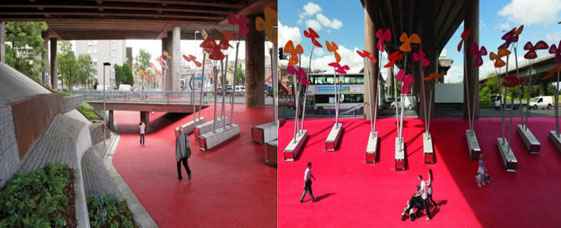
Landscape art design under the viaduct of Garscube Road in Scotland. From: https://www.ideabooom.com/7571.
4. PRACTICAL RESEARCH ON THE ACCESSORY SPACE OF DONGDU OVERPASS
4.1. Current Situation of the Site
Dongdu Overpass Park is located on the north and south sides of Xianyue Road, Huli District, Xiamen City. The Haicang Bridge passes through the park from west to east and intersects with three overpass bypasses above the park. It is a park-like landscape under the Haicang Bridge. There are abundant tourism resources around the park, including Haicang Bridge Tourist Area and Dongdu Cultural Curio City. In addition, surrounding areas are mostly residential areas. Because Dongdu Overpass Park is close to the Haotou bus station, its special geographical location has become a shortcut and hub for people to walk. People often pass through the park under the viaduct to shorten the walking distance and time, forming a convenient passage for life and commuting, and there is a lot of crowd traffic in the park under the viaduct.
Dongdu Overpass Park covers an area of about 4,000 square meters. The highest column under the bridge is about 20m and the shortest is about 6m. The park is relatively less affected by car noise and exhaust from the viaduct overhead. The landscape green space under the viaduct is in the form of a closed green space, without public entertainment facilities and only simple landscape infrastructure for tourists to rest. At present, Dongdu Overpass Park is used as public leisure space under the viaduct for the surrounding people (Fig. 2). However, due to disrepair, the park is shabby and dim, the space lacks vitality, and there are not many people who stop and stay for a long time.
4.2. Sorting Out Related Issues
The Fujian Provincial Department of Housing and Urban-Rural Development has put forward a corresponding comprehensive utilization adjustment plan for the problem under the viaduct: to tap the space under the viaduct as much as possible for municipal administration, environmental sanitation, landscaping, open green space or leisure space, etc., to improve the utilization rate of the space under the viaduct. The space under the Dongdu Overpass is used as an urban park-type space, and the overall streamline layout of the space is a linear extension form with a single streamline. The large area of usable space under the viaduct has only a simple streamline planning, the use function of the space has not been well utilized, and the design of the landscape environment exists in isolation and lacks the intervention of design aesthetics. The visual color of the park space is mostly foggy and heavy gray, and the lack of bright colors in color often creates a sense of distance for tourists. The three-dimensional greening of the space under the viaduct is only a duplication of materials and techniques. This copy-and-paste design pattern only makes the urban landscape environment appear less creative, less individual and less distinctive. It is difficult for such ordinary and similar urban culture and urban landscape to rise to the artistic level that the public is satisfied with [6].
In addition, there is a lack of necessary management and maintenance in Dongdu Overpass Park and there are certain hidden safety hazards. Without reasonable installation of automatic sprinkler irrigation devices, there is often a small amount of ponding and mud on the roads in the park, not only affecting the visual impression of the park under the viaduct to the public, but also bringing certain safety hazards to the passing tourists. There are also many designs that do not meet ergonomic specifications. For example, the distance between the lawn steps over water of the secondary roads doesn't meet the human stride requirements, and the distance between the two steps over water is greater than the normal walking comfort range of 100-200mm. The number of steps at the east entrance is also too steep. Various unreasonable planning arrangements and the loss of space aesthetics have led to a decrease in the participation of surrounding people in the space under the viaduct (as shown in Fig. 3). It fails to make the park a necessary functional supplement to people's surrounding life.
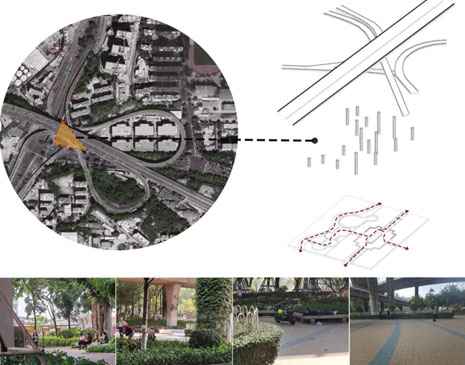
Current situation of space usage under the Dongdu Overpass. From: author’s on-site photography and self-drawn.
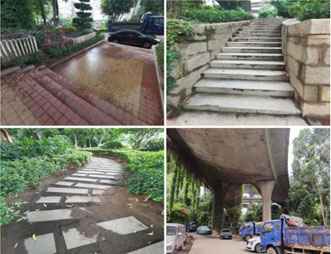
Current situation of the space under the Dongdu Overpass. From: author’s on-site photography.
5. PRACTICAL STRATEGIES UNDER THE INTERVENTION OF PUBLIC ART
5.1. Using Colors to Enrich Spatial Layers
People are 80% sensitive to colors and 20% sensitive to modeling. Therefore, color is the first element that affects the senses [7]. The degree of the importance of colors to the composition of the urban landscape can be told. However, the color processing of the space under the viaduct is relatively simple. For the functional distinction of space, different bright colors can be used to distinguish. For example, bright and vibrant colors such as red, white, orange, and yellow can be used to open up the color level of the space, colors such as red and orange can be used in sports and dynamic spaces, and mild colors with low saturation such as light yellow and light brown can be used in public leisure spaces. The colors of plants also occupy a certain share of the space under the viaduct. Plants should be regarded as a kind of soft material, and it should not only pay attention to the functional requirements, but also pay attention to the visual characteristics under the current viaduct. It is necessary to adjust it when planning the space and place plants with different colors such as Photinia Fraseri, Rosa Multiflora, Hemerocailis Middendorffi, Ligustrum Quihoui, Hosta Plantaginea, and Edgeworthia Chrysantha, in order to inject fresh vitality into the space under the viaduct and create an artistic and modern atmosphere of the space.
5.2. Using Art Installations to Activate the Features Under the Viaduct
Often, the planning for the space under viaduct lacks eye-catching features. Placement of art installations can drive the vitality of the original site, satisfy people's spiritual and psychological yearning, enrich urban public activities, and achieve the purpose of enhancing urban vitality [8]. Art installations can be works of art with different shapes to enhance the ornamental value of the space. However, due to the particularity of the space under the viaduct, more attention should be paid to its interaction with people and functional attributes. In response to the problem under the viaduct, it is necessary to design the columns, bridge shade, and green space in the space under the viaduct, and use materials such as tempered glass, acrylic plate, aluminum plate, and LED lights to integrate with the elements of the space (such as Fig. 4). By doing so, it can play the viewing function of guiding interaction and beautifying the space during the day and become an artistic lamp for luminous lighting at night (such as Fig. 5).
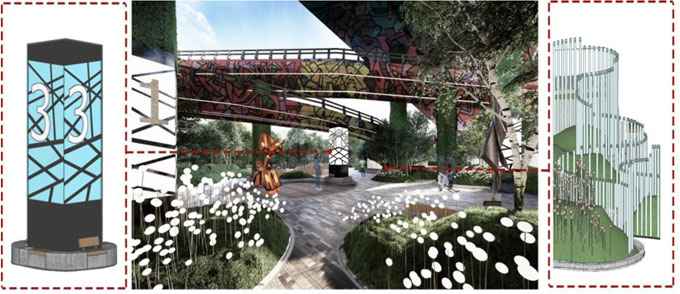
Design sketch and illustration of the space under the viaduct under the intervention of art installations. From: drawn by the author.
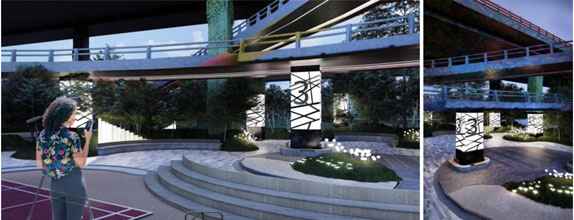
Nighttime design sketch of the space under the viaduct under the intervention of art installations. From: drawn by the author.
5.3. Using Artistic Events to Shape the Vitality Under the Viaduct
Public participation is one of the three elements of public art, i.e. the space where public art intervenes should eventually form a space for interaction and communication between people. The enthusiasm of the space means that the space can attract and satisfy people's basic use intentions, set up a complex functional landscape space to meet the different needs of users, increase the frequency of space use, and realize the intensive use of space resources. For example, different leisure functions and sports activities can be added to a single landscape function, and a specific theme culture can be implanted, so that users can experience the characteristic space activities under the viaduct while performing leisure activities (such as Fig. 6). For the space under the Dongdu Overpass, art activities can be used to infect and spread the surrounding people in a small area to achieve the effect of attracting the attention of the surrounding people. Through the multi-dimensional utilization of art events such as festival culture, art fairs, and concerts under the viaduct, the pattern of the utilization of space can be integrated and enriched (such as Fig. 7), and combined with related art beautification and improvement, the space can be naturally integrated into the daily life of the surrounding people, in order to make better use of the space under the viaduct, improve the living environment and happiness of residents, inject fresh vitality into the space under the viaduct, create an artistic atmosphere and modern atmosphere of the space, and enhance the image of the city.
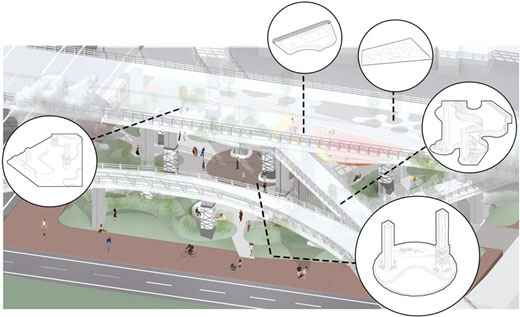
Analysis of space under the viaduct under the placement of different functional areas. From: drawn by the author.
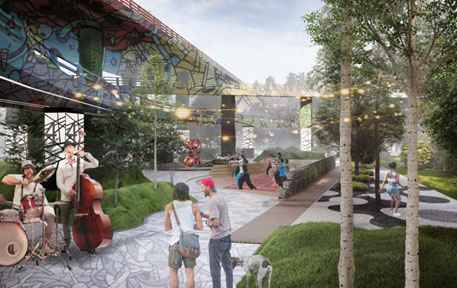
Design sketch of the space under the viaduct under the intervention of art events. From: drawn by the author.
6. CONCLUSION
This article interprets the related concepts and meanings of public art and proposes practical strategies based on the space under the Dongdu Overpass. Public art intervention in the space under the viaduct doesn't mean blindly pursuing the artistic and aesthetic attributes of the space. It is important to consider humanistic attributes of public art in the first place and put forward relevant practical application strategies based on an analysis of the social, economic and practical benefits of the space under the viaduct. Of course, the concept of public art will change with the progress of the times. The landscape construction mode of public art intervening in the space under the urban viaduct is also constantly innovating. It is also necessary to combine the actual situation and future development trends of China, in order to constantly explore the way to create the landscaping under the urban viaduct that is suitable for China.
REFERENCES
Cite This Article

TY - CONF AU - Haowei Lin PY - 2022 DA - 2022/11/21 TI - Design Strategies of Viaduct Accessory Space From the Perspective of Public Art: Taking Xiamen Dongdu Overpass Park as an Example BT - Proceedings of the 8th International Conference on Arts, Design and Contemporary Education (ICADCE 2022) PB - Athena Publishing SP - 225 EP - 231 SN - 2949-8937 UR - https://doi.org/10.55060/s.atssh.221107.035 DO - https://doi.org/10.55060/s.atssh.221107.035 ID - Lin2022 ER -









